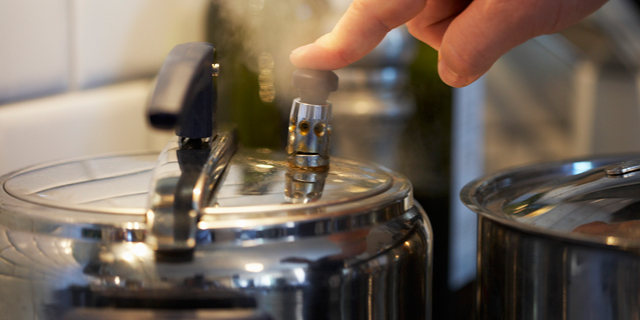With a magical ability to shave cooking times to a third, the pressure cooker is a kitchen essential for chefs in the know. While many modern home cooks may be novices to using this tool today, in the era of Lucy and Desi, it was the secret weapon of housewives for prepping the perfect pot roast in record time. The pan’s combustible potential requires a bit of extra caution, but shouldn’t prevent you from experiencing the explosive flavor combinations you can achieve when using one.
According to Peggy Trowbridge Filippone, About.com’s natural cooking expert, the first commercial pressure cooker, made by National Presto Industries, was unveiled at New York World’s Fair in 1939. The pan has a locking lid to create intense steam heat that cooks foods in a shorter period of time when compared to a conventional saucepan, while capturing their flavors and nutrients – resulting in healthier, more tender meals. Here’s how you you can use your pressure cooker, worry free.
Choosing a Pressure Cooker
Selecting for Safety: Nowadays, modern pressure cookers utilize as many as three safety features to reduce the dangers that come from common user errors like forgetting to reduce heat on the stovetop after reaching the highest level of pressure, which is generally 15 pounds per square inch. Make sure your pressure cooker offers you safety options.
Beneath the Surface: Picking a pressure cooker made of 18/10 stainless steel that sandwiches aluminum or copper into a three-ply bottom will ensure the most evenly distributed heat to avoid burning or sticking.
Size Matters: You can under-fill a pressure cooker but can only pack it to 2/3 capacity. A good rule of thumb is to buy the biggest pan you’ve got room to store to give you optimum flexibility in the future.
Required Reading: Each pressure cooker has its own intricacies and specifics. Invest a few moments into reading your user’s manual from cover to cover before taking it for a spin in the kitchen the first time.
Next up, using your pressure cooker, including recipes…
[pagebreak]Using a Pressure Cooker
Spice it Up: High cooking heat can mute the flavor intensity of some spices. For best results, use whole spices during the pressure cooking process and save ground spices and fresh herbs for stirring in after the lid is removed when cooking concludes.
Sauce Secrets: Avoid waterlogged sauce by getting a pressure cooker that needs no more than a cup of liquid to establish its highest pressure level. Test your cooker for intervals of 20, 40, and 60 minutes using 4 ounces of water each time to determine the level of liquid loss that occurs during cooking. In some cases, adding liquids midway through the cooking process is necessary to prevent scorching.
Release the Pressure: No matter how modern or vintage your pressure cooker, there’s a foolproof way of diffusing its pressure. Tilting your pan into your kitchen sink at a 45-degree angle while running cold water over its lid away from the pressure regulator for 30 to 60 seconds will help quickly dissipate the pressure built up inside before its opened.
Give it a Rest: When kept uncovered for three to five minutes after removing the lid, pressure cooked foods will continue to develop flavors and textures while maintaining an adequately hot serving temperature.
Recipe Inspirations
Pressure cookers are prized possessions in sweltering Latin kitchens far and wide because they significantly reduce the time spent slaving over a hot stove, while enhancing instead of compromising the textures and flavors of each dish. Here, a few of our favorite recipes to get you started.
BBQ Pulled Pork Tacos – pork shoulder is pronto in just one hour compared to eight in the slow cooker.
Frijoles Negros a la Cubana – black beans need four hours of soaking time before pan preparation, but you can skip this step with a pressure cooker.
Ropa Vieja – shredded beef is seasoned and table-ready in a quarter the traditional recipe’s time, less than 30 minutes.


![Making Mealtime Matter with La Familia: Easy Sofrito [Video]](https://thelatinkitchen.com/wp-content/uploads/2015/10/sofrito-shutterstock__0-500x383.jpg)
![Easy Latin Smoothies: Goji Berry Smoothie [Video]](https://thelatinkitchen.com/wp-content/uploads/2015/12/goji_berry-shutterstock_-500x383.jpg)
















![Fun and Fast Recipes: Fiesta Cabbage Salad [Video]](https://thelatinkitchen.com/wp-content/uploads/2015/11/fiesta_cabbage_slaw-shutterstock_-500x383.jpg)









